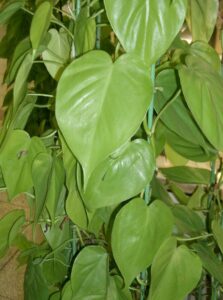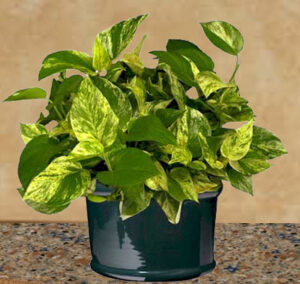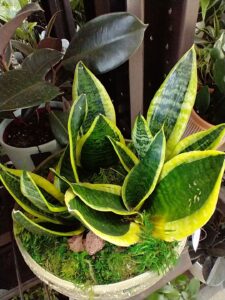
Heather N. Kolich, ANR Agent, UGA Extension Forsyth County
There are many research studies that extoll the health benefits of being outdoors in nature. But other studies show that most people spend 70 percent or more of their time indoors. Fortunately, houseplants can give us mental and physical health boosts similar to what we experience from natural environments.
Various research findings indicate that houseplants in our homes or dorm rooms can lower blood pressure, decrease feelings of anxiety and depression, improve mood, and increase mental and emotional wellbeing. In the workplace, houseplants can improve focus and productivity, decrease stress, and make us feel more satisfied with our jobs. In hospitals, several studies documented that patients healed faster, had lower blood pressure, and used less pain medication when a plant was in their room as compared to similar patients recovering from the same surgery without a houseplant companion.
As with skill development, the mental benefits of houseplants increase with practice. People with years of experience caring for houseplants reported higher levels of mental well-being and mindfulness than novice houseplant keepers. Finding the right houseplant, one that is compatible with the environment and the level of care that you can give it, is more likely to result in an enjoyable and successful outcome. So, whether you are a beginner or an expert, let me introduce you to some rewarding, easy-care houseplants to improve your indoor space and your sense of wellness.
Heartleaf Philodendron

The popularity of heartleaf philodendron (Philodendron hederaceum) is testimony to its durability and easy care. As the name implies, this tropical trailing or climbing vine has large, glossy, heart-shaped foliage. It tolerates low light, but grows better with medium, indirect light. Keep the soil moist, lightly fertilize every 3-4 months, and remove dead leaves. When you trim the vine, plant the cuttings in moist potting soil to start new plants.

Golden Pothos
Another tropical vine with heart-shaped leaves, pothos differs from philodendron by the ridges on its stem and variegated leaf coloration. Golden pothos (Epipremnum aureum) leaves have gold or yellow marks. Bright, indirect light helps bring out those color highlights, but pothos will survive in low light. The long vines can be showcased in a hanging basket, cascading over a plant stand, or climbing up a post with the help of aerial roots that sprout from the stem. To grow pothos as a bushy plant, trim the vines back to just a few inches. Plant the stem cuttings to grow new plants. Allow the top of the soil to dry between waterings.

Snake Plant
Snake plants (Dracaena marginata) come in a variety of sizes, have different leaf widths, and different leaf markings. What they all have in common are their rigid, upright leaves and their loyal, forgiving nature. They grow in bright to low light, won’t mind if you sometimes forget to water them, and enjoy being root-bound. Table-top cultivars stay around 6-inches tall while larger varieties reach heights of 3-4 feet.
Spider Plant
The long, narrow, white and green leaves of spider plants (Chlorophytum comosum) show well in hanging baskets or nodding over the planter on a table. Provide spider plants with bright, indirect light and moist soil. Go lightly on fertilizer. Spider plants bloom, but the flowers are small. It’s what happens next that’s interesting. The flowers develop into little plantlets along the dangling flower scape. When aerial roots develop, snip the plantlet from the stem and plant it in moist potting soil so you can share houseplant joy and wellness with others.
Notes

It’s good practice to keep houseplants out of the reach of children and pets as some contain toxins that can make children, dogs, and cats sick if they chew plant leaves or stems. All parts of philodendron (low toxicity) and pothos (medium toxicity) plants contain calcium oxalate crystals that can cause pain and swelling in mouth parts, drooling, diarrhea, and vomiting. Snake plant (low toxicity) contains saponins, which produce similar symptoms if ingested and skin irritation with exposure to the plant sap. Spider plants are considered non-toxic.